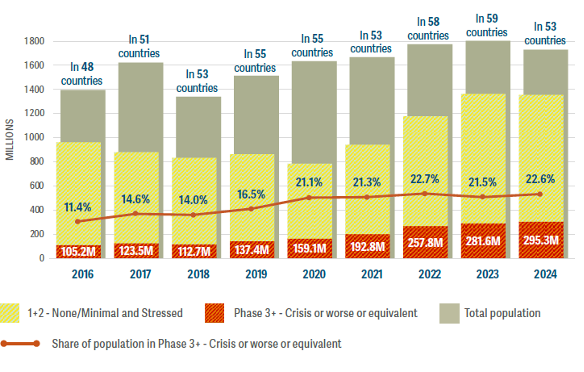Rising food insecurity, waning humanitarian assistance: 2025 Global Report on Food Crises released

- Global Report on Food Crises
- Food Crisis and Related Risk Factors
- Food Assistance
- Hunger
- Nutrition
- Risk and Resilience
- Climate Change
- Food Crisis and Related Risk Factors
- Conflict
Related blog posts
The world faced a stark inflection point in 2024, as the continued rise in the number of people facing crisis-to-catastrophic levels of acute food insecurity meets sharp reductions in funding for humanitarian assistance. The 2025 Global Report on Food Crises (GRFC), released today, reports that 295.3 million people across 53 countries/territories faced acute food insecurity in 2024. This represents a tripling of the number of people facing acute hunger since 2016 and a doubling since 2020 (Figure 1).
Figure 1
Prevalence and number of people facing high levels of acute food insecurity, 2016-2024
Source: FSIN, 2025 Global Report on Food Crises
Note: Prevalence of crisis-level or worse acute food insecurity (IPC3+) as percentage of analyzed population. Numbers of people facing those conditions in millions.
Reductions in official development assistance (ODA) contributed to the alarming rise and will only continue to compound the crisis if policymakers do not revive their commitment to humanitarian aid.
This is now most pressing as the number of people facing IPC Phase 5 (Catastrophe)-level food insecurity more than doubled from 2023, with populations Sudan, the Gaza Strip, South Sudan, Haiti, and Mali being impacted (Figure 2).
Figure 2 Countries and territories with populations at high risk of famine (IPC Phase 5 – Catastrophe) in 2024
Source: FSIN, 2025 Global Report on Food Crises
The report cites conflict as the main driver of worsening Phase 5 conditions in these countries, as well as of acute food insecurity overall in 20 of the report’s 65 covered countries and territories. Of particular concern, the IPC Famine Review Committee (FRC) confirmed the existence of famine conditions in parts of Sudan, marking the first time famine was confirmed in the world since 2020.
In the Gaza Strip, the IPC FRC also found more than half of the population at risk of famine throughout 2024, although with off-and-on improvements in shipments of humanitarian assistance, available evidence had not confirmed actual famine conditions. With the recent end of the Israel-Hamas ceasefire, renewed mass displacement of the population and the virtual halt to food and other humanitarian assistance coming into the Gaza Strip in the first quarter of 2025, IPC now projects the entire population of Gaza currently faces crisis-level acute food insecurity, of which nearly 500,000 are on the verge of famine. The risk of famine is also spreading rapidly in Sudan as that country’s violent conflict intensifies.
Elsewhere, climate change-related extreme weather was the primary drivers of acute food insecurity in 18 countries, affecting more than 96 million people. Economic shocks drove acute food insecurity in 15 countries and impacted more than 59 million people.
As in previous years, none of these drivers acted in a vacuum. Rather, conflict, economic shocks, and extreme weather exacerbated each other’s impacts, creating vicious cycles of livelihood disruption, population displacement, and hunger and malnutrition. Understanding how these drivers converge is crucial to designing interventions and policies to build countries’ resilience to shocks.
Also crucial is an understanding of countries’ vulnerability and capacity to respond to shocks and potential resulting food crises. Of the 16 countries with the greatest magnitude and prevalence of acute food insecurity in the GRFC 2025, most also had both high vulnerability to shocks and low coping capacity. A range of structural, economic, and sociopolitical factors inform both measurements, including a country’s infrastructure, agricultural market structure, and fiscal ability to invest in social safety net programs and disaster prevention and response mechanisms.
Countries with both high vulnerability to shocks and low coping capacity rely heavily on external financial assistance. Of the 65 countries/territories covered by the 2025 GRFC, 11 received ODA of more than 10% of their gross national income (GNI).
This raises serious concerns given the termination of most international assistance from the United States in early 2025. Also, financial support from other major donor countries has come under pressure of announced budget cuts. The GRFC reports that an abrupt and significant deterioration in the outlook for humanitarian aid in 2025, with allocations to food sectors potentially falling by as much as 45%.
These cuts would come at a time when more than 231 million people are expected to face high levels of acute food insecurity in 2025 based on preliminary data as of May 12, 2025.
The risk of food crises spreading and deepening is high, with the intensification of multiple conflicts and sustained high vulnerability to weather extremes in many of the countries and territories facing acute food insecurity. In addition, high uncertainty over the trade and macroeconomic policies of major economies has caused turmoil in financial markets and is affecting economic activity around the world, risking severe slowdown of global economic growth with likely adverse impacts on food security in low-income countries. Building more resilient, inclusive, and sustainable food systems for all will take significant political and financial commitment, but as the 2025 GRFC highlights, the time for such commitment is now—before protracted food crises and the risk of famine will affect tens of millions more people and become more difficult to contain.
Sara Gustafson is a freelance writer and communications consultant. Rob Vos is a Senior Research Fellow in IFPRI's Markets, Trade, and Institutions Unit.

